[Ba]king [Br]ead Developer Guide
Acknowledgements
This project is based on the AddressBook-Level3 project created by the SE-EDU initiative.
Setting up, getting started
Refer to the guide Setting up and getting started.
Design
Architecture
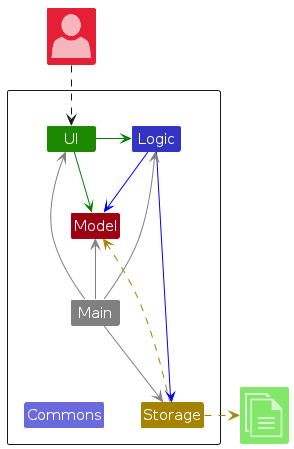
The Architecture Diagram given above explains the high-level design of the App.
Given below is a quick overview of main components and how they interact with each other.
Main components of the architecture
Main (consisting of classes
Main and
MainApp) is in
charge of the app launch and shut down.
- At app launch, it initializes the other components in the correct sequence, and connects them up with each other.
- At shut down, it shuts down the other components and invokes cleanup methods where necessary.
The bulk of the app's work is done by the following four components:
UI: The UI of the App.Logic: The command executor.Model: Holds the data of the App in memory.Storage: Reads data from, and writes data to, the hard disk.
Commons represents a collection of classes used by multiple other components.
How the architecture components interact with each other
The Sequence Diagram below shows how the components interact with each other for the scenario where the user issues the command delete 1.
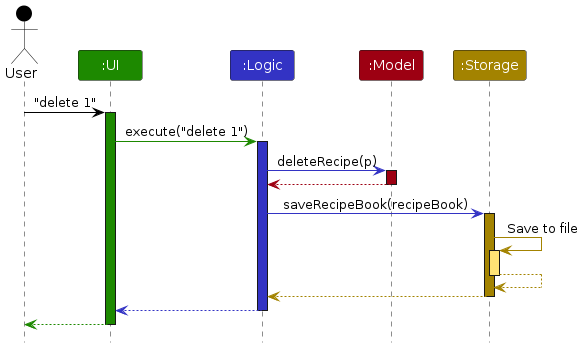
Each of the four main components (also shown in the diagram above),
- defines its API in an
interfacewith the same name as the Component. - implements its functionality using a concrete
{Component Name}Managerclass (which follows the corresponding APIinterfacementioned in the previous point.
For example, the Logic component defines its API in the Logic.java interface and implements its functionality using the LogicManager.java class which follows the Logic interface. Other components interact with a given component through its interface rather than the concrete class (reason: to prevent outside component's being coupled to the implementation of a component), as illustrated in the (partial) class diagram below.
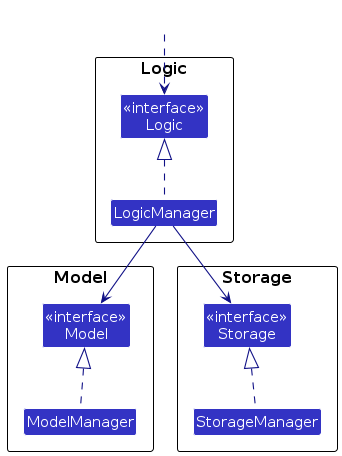
The sections below give more details of each component.
UI component
API: Ui.java
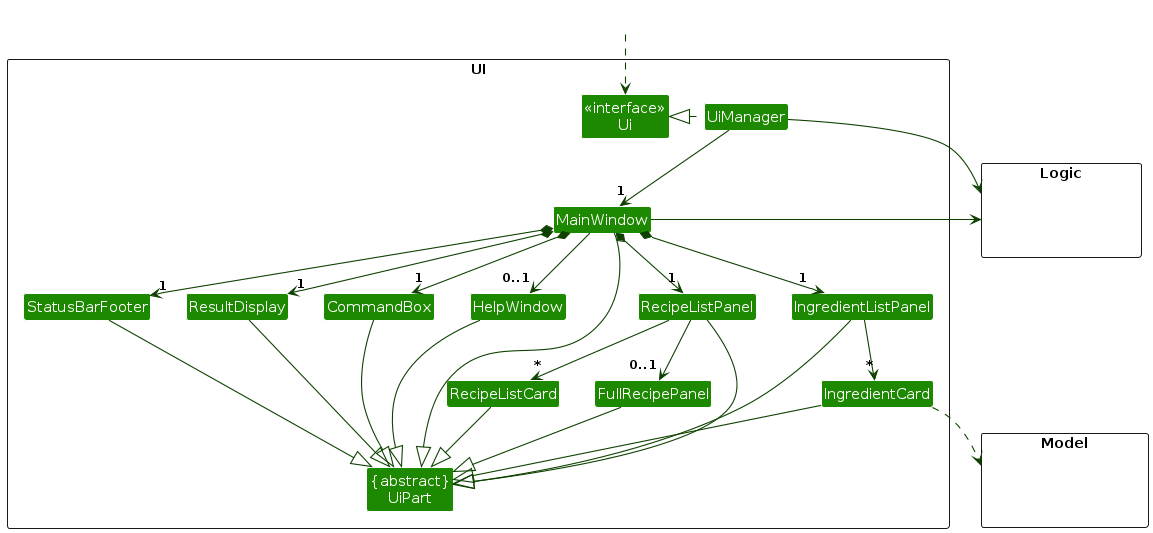
The UI consists of a MainWindow that is made up of parts e.g.CommandBox, ResultDisplay, IngredientListPanel,
RecipeListPanel StatusBarFooter etc. All these, including the MainWindow, inherit from the abstract UiPart class
which captures the commonalities between classes that represent parts of the visible GUI.
The UI component uses the JavaFx UI framework. The layout of these UI parts are defined in matching .fxml files that
are in the src/main/resources/view folder. For example, the layout of the
MainWindow
is specified in
MainWindow.fxml
The UI component,
- executes user commands using the
Logiccomponent. - listens for changes to
Modeldata so that the UI can be updated with the modified data. - keeps a reference to the
Logiccomponent, because theUIrelies on theLogicto execute commands. - depends on some classes in the
Modelcomponent, as it displaysInventoryobject residing in theModel.
Model Component
API: Model.java
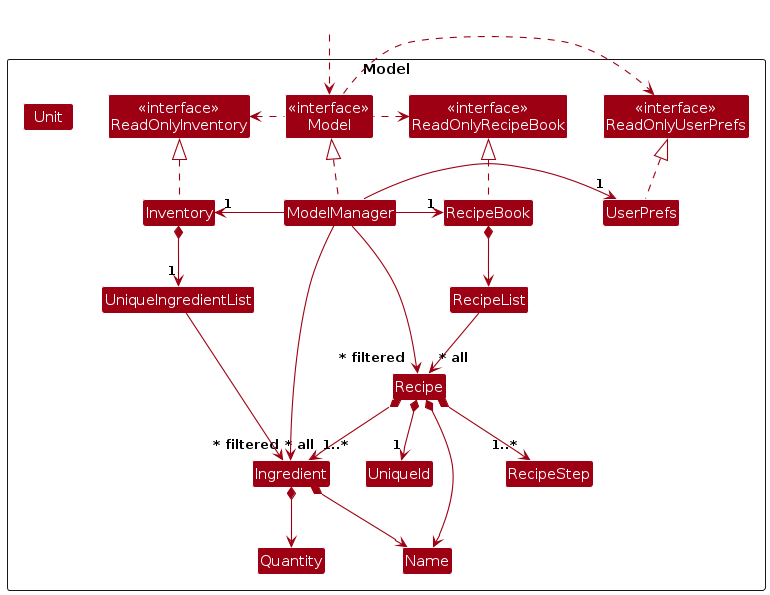
The Model stores Ingredient and Recipe, the main components of this product. It provides the API to interact with
the available list of Ingredient and Recipe.
The Model component,
- stores a
UserPrefobject that represents the user's preferences. - stores the
Inventorydata. - stores the
Recipe Bookdata. - exposes an unmodifiable
ObservableList<Ingredient>,ObservableList<Recipe>that can be 'observed' by the UI. - does not depend on the other three components
Storage Component
API: Storage.java
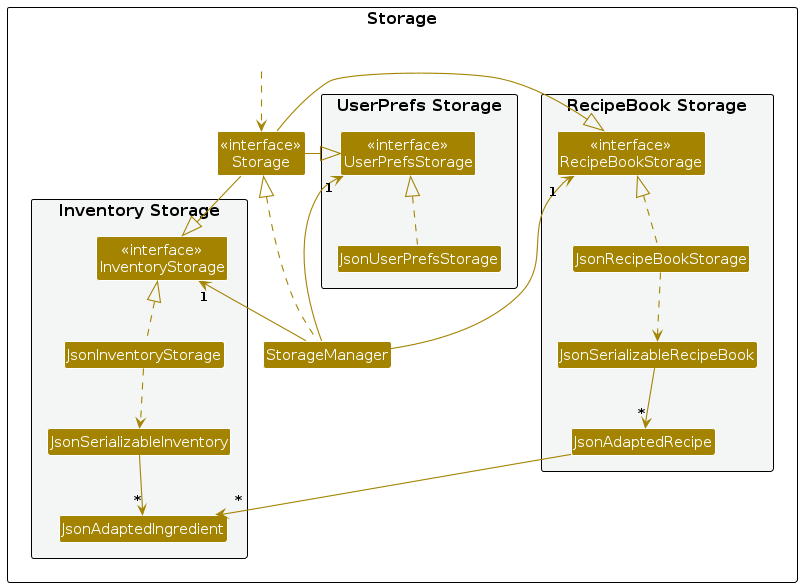
The Storage manages the saving and reading of currently available Ingredient and Recipe to local storage.
It allows users to use the product as-is throughout different sessions.
The Storage component,
- consists of an Inventory Storage and Recipe Book Storage sub-component.
- saves the
UserPrefobject in json format and read it back. - saves the
Inventoryobject in json format and read it back. - saves the
RecipeBookobject in json format and read it back.
Implementation
This section describes some noteworthy details on how certain features are implemented.
Search ingredient feature
Implementation
The search ingredient mechanism is implemented as a Command, extending from the Command abstract class.
Given below is an example usage scenario and how the search ingredient mechanism behaves at each step. The applicacation
is assumed to be initialised with at least one ingredient loaded in the ModelManager.
Step 1. The user keys in stock Flour into the UI command box. LogicManager takes this string command and executes it.
Step 2. InventoryAppParser is then called to parse the stock Flour command.
Step 3. StockCommandParser is then called to handle the parsing. The parse(String args) function is called with
the argument "Flour".
Step 4. NameContainsKeywordsPredicate predicate object is created which returns true for any ingredients tested on
the predicate with a name containing the phrase "Flour". This step is case-insensitive.
Step 5. The StockCommand then filters the inventory in ModelManager according to the predicate.
Step 6. The MainWindow in the ui detects that there are some items in the filtered inventory, and proceeds to
display ingredients satisfying the predicate
StockCommand calls Model#updateFilteredIngredientList(Predicate<Ingredient> predicate), filtering the
ingredient list in ModelManager according to the predicate set.
Alternatives considered:
An alternative implementation of the stock command would be to find the ingredient that matches the query perfectly, resulting in either 0 or 1 ingredients are filtering. Each ingredient should have a unique name, hence an ingredient with any name can either only be stored in the inventory or not, and therefore the search result will be more specific, and potentially more convenient to use.
However, we expect users to have multiple ingredients with a common word, as natural language tends to group items of a similar nature in the same group of phrases (eg. eggs and duck eggs). Hence, we have decided that searching for items whose name contains the phrase of the query is more suitable for home bakers, considering the number of repeated phrases and expressions commonly used in baking.
Add recipe feature
Implementation
The add recipe mechanism is implemented as a Command, extending from the Command abstract class.
Given below is an example usage scenario and how the add recipe mechanism behaves at each st ep.
Step 1. The user keys in the following command.
addrecipe
Step 2. RecipeAddInputHandler is then used to control how the input is handled, preventing other commands from being used.
Step 3. The user keys in the name of the recipe.
Cookie
Step 4. RecipeAddInputHandler passes the string to RecipeAddCommandParser, which parses it into a Name instance.
Step 5. The user enters as many ingredients as they like one by one, in the following format:
flour 100g
Step 6. Each string is parsed by the RecipeAddCommandParser, and the parsed Ingredient instance is added to a list.
If a parsing error occurs, no ingredient is added, but the recipe creation still continues.
Step 7. The user enters steps start to cease the adding of ingredients and begin writing steps.
Step 8. Each string is parsed by the RecipeAddCommandParser, and the parsed RecipeStep instance is added to a list.
If a parsing error occurs, no step is added, but the recipe creation still continues.
Step 9. A new Recipe instance is created using the Name, List<Ingredient> and List<RecipeStep>.
The List<RecipeStep> is sorted by step number.
Step 10. A RecipeAddCommand instance is created by the RecipeAddCommandParser, which is passed to the ModelManager and executed.
Step 9. The RecipeAddCommand adds the new Recipe instance to the recipe list in ModelManager.
The following sequence diagram shows how the add recipe operation works:

Alternatives considered:
An alternative implementation of the recipe add command would be to only specify the name, and add the ingredient and step lists later using recipe modifying commands. This would reduce the size of the command, leading to lower chances of user input error.
However, modifying the recipe through commands may be more slow than typing everything at once, since more command words need to be used. Furthermore, when inputting a recipe, users are likely to copy and paste the ingredient list and steps from another source. As such, errors in input should be unlikely. It is also easy to see where an error may be in the input, since the format is very readable, with little tokens and command words.
View recipe feature
Implementation
The view recipe mechanism is implemented as a Command, extending from the Command abstract class.
Given below is an example usage scenario and how the view recipe mechanism behaves at each step. The application is
assumed to be initialised with at least one recipe loaded in the ModelManager.
Step 1. The user keys in view 1 into the UI command box. LogicManager takes this string command and executes it.
Step 2. InventoryAppParser is then called to parse the view 1 command.
Step 3. By Polymorphism, RecipeViewCommandParser is called on to handle the parsing. The parse(String args) function
is called with the argument of "1"
Step 4. A RecipeUuidMatchesPredicate object is created which returns true for any recipe tested on the
predicate with the same unique identifier (UUID) of 1.
Step 5. The RecipeViewCommand then filters the recipe list in ModelManager according to the predicate. The recipe
list should only have at most 1 item after filtration.
Step 6. If there is a recipe with the same UUID inputted by the user in the recipe book, the MainWindow in ui will
detect that there is one item in the recipe list, and proceed to display the full recipe.
RecipeViewCommand calls Model#updateFilteredRecipeList(Predicate<Recipe> predicate), filtering the
recipe list in ModelManager according to the predicate set.
The following sequence diagram shows how the view recipe operation works:
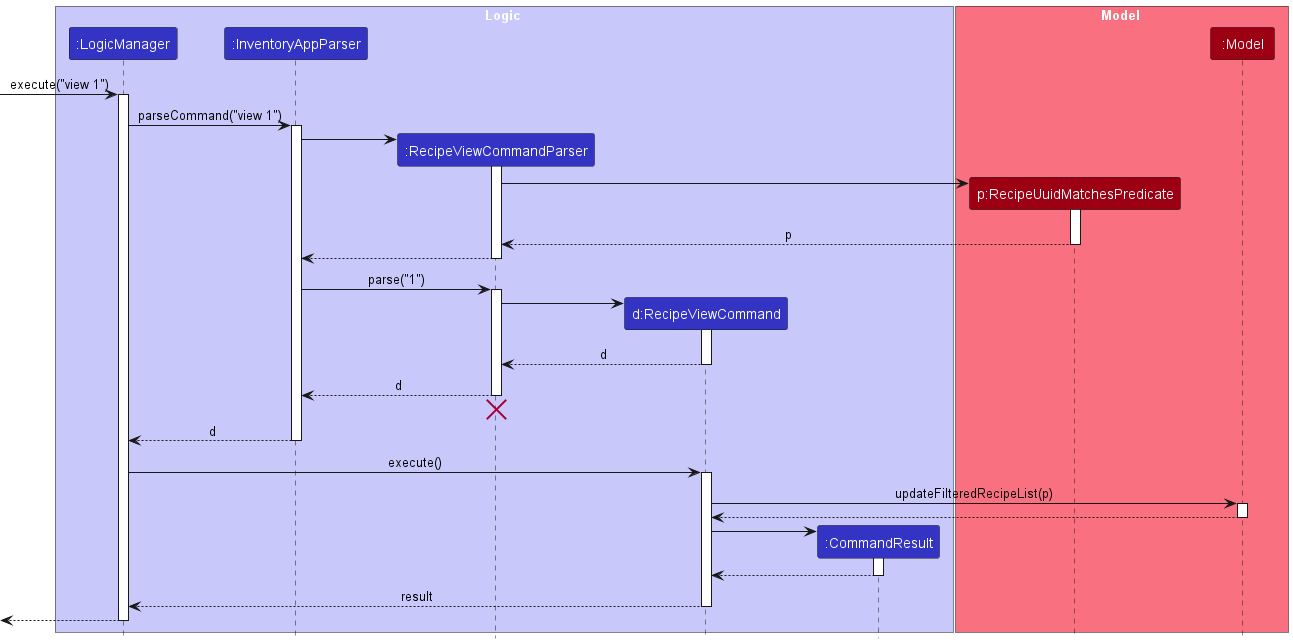
Note: If the argument is an invalid UUID (less than or equals to 0), a
ParseException will be thrown and users will be informed that the UUID provided is invalid.
Note: If the recipe with that UUID does not exist in the app, a CommandException will be thrown and users will be
informed that there is no recipe with that UUID in the recipe book.
Note: The lifeline for RecipeViewCommandParser should end at the destroy marker (X) but
due to a limitation of PlantUML, the lifeline reaches the end of diagram.
Alternatives considered:
An alternative implementation considered is to find the first recipe with UUID that matches instead of filtering through the whole recipe list. Each recipe has a unique id, and hence the first instance of a recipe with match UUID should be the only recipe with that UUID. This could lead to faster search times to view a specific recipe.
However, we do not expect a user to have so many recipes that performance would become an issue. We do not expect users to be frequently using this command either, since baking something requires much time and effort. Filtering through the whole list also confers an advantage of being able to assert that there is at most one such recipe with that particular UUID.
List recipe feature
Implementation
The List feature is implemented as a type of Command. It extends the abstract class Command.
Given below is an example usage scenario and how the list feature behaves at each step. The recipe storage is assumed to
be initialised with at least 2 recipes within ModelManager.
Step 1. The user launches the application. All recipes will be shown as the current recipeList has not been filtered.
Step 2. The user executes view 1. The view command will then update the recipeList to only contain the filtered
recipe.
Step 3. The user then executes list. The list command will be parsed using the Inventory App Parser within
LogicManager.
Step 4. This parsed command will be executed once again with LogicManager.
Step 5. During execution, ModelManager#updateFilteredRecipeList will be called with the PREDICATE_SHOW_ALL_RECIPES
to update the current recipeList with all the recipes.
Step 6. After execution, the returned CommandResult will then be returned back to the MainWindow to be displayed.
The following sequence diagram shows how the list recipe feature works:
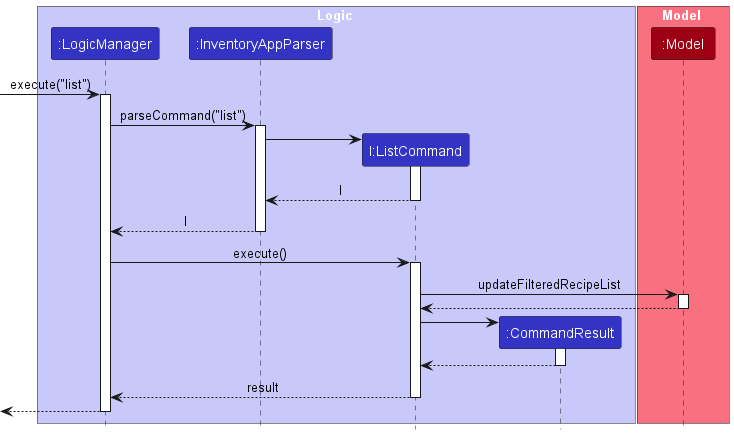
Design Considerations:
Aspect : How view executes:
- Alternative 1 (Current Choice): Gets the list from the "RecipeBook"
- Pro: Easy to implement
- Con: Need to constantly store current state
- Alternative 2: Read the list from the storage
- Pro: No need to store current state after command
- Con: Need to access storage
Search recipe feature
Implementation
The search recipe mechanism is implemented as a Command, extending from the Command abstract class.
Given below is an example usage scenario and how the search feature behaves at each step. For this scenario, it is assumed
that at least one recipe is loaded into ModelManager
Step 1. The user launches the application. All recipes will be shown as the current recipeList has not been filtered.
Step 2. The user executes search flour. The search command will be parsed using the Inventory App Parser within
LogicManager.
Step 3. By Polymorphism, SearchCommandParser is called on to handle the parsing. The parse(String args) function
is called with the argument of "flour".
Step 4. A RecipeIngredientNameMatchesPredicate will be with the argument "flour" as its parameter.
Step 5. The SearchCommand then filters the recipe list in ModelManager according to the predicate. The recipe
list will display all recipes that require "flour".
Step 6. After execution, the returned CommandResult will then be returned back to the MainWindow to be displayed.
SearchCommand calls Model#updateFilteredRecipeList(Predicate<Recipe> predicate), filtering the
recipe list in ModelManager according to the predicate set.
The following sequence diagram shows how the search recipe feature works:
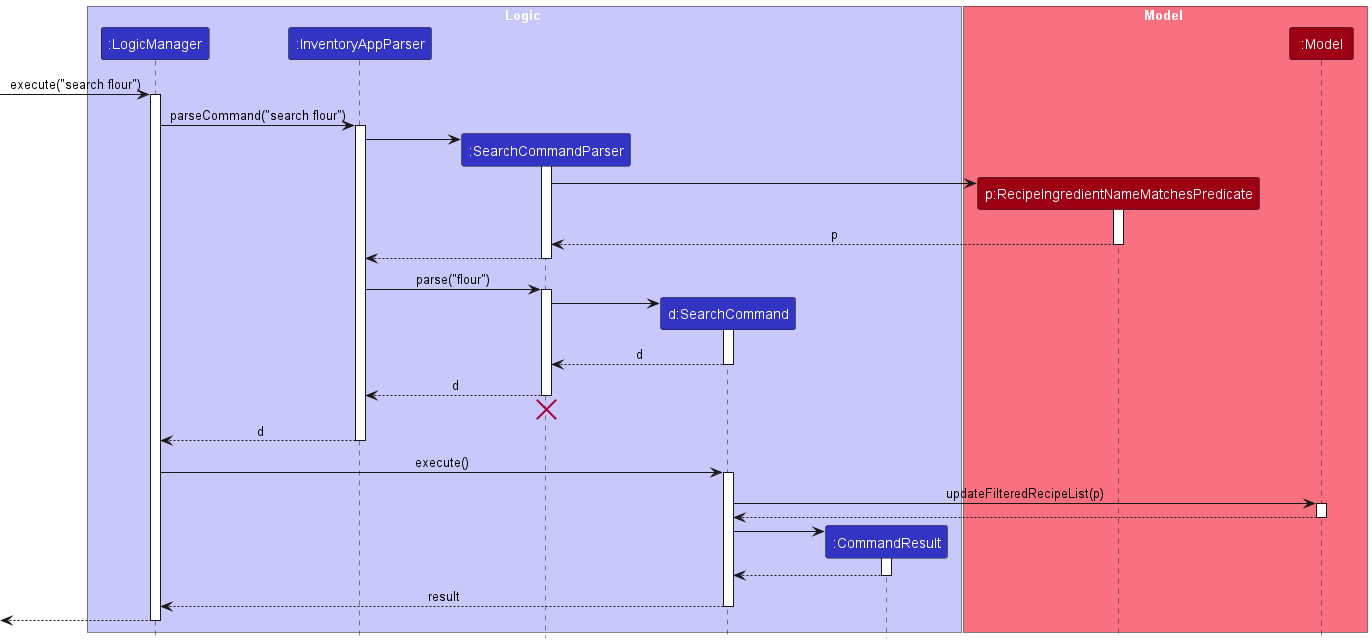
Delete recipe feature
Implementation
The delete recipe mechanism is implemented as a Command, extending from the Command abstract class.
Given below is an example usage scenario and how the delete recipe mechanism behaves at each step. The application is
assumed to be initialised with at least one recipe loaded in the ModelManager.
Step 1. The user keys in delete 1 into the UI command box. LogicManager takes this string command and executes it.
Step 2. InventoryAppParser is then called to parse the delete 1 command.
Step 3. By Polymorphism, DeleteCommandParser is called on to handle the parsing. The parse(String args) function is
called with the argument of "1" and the "1" is parsed as an Integer. This integer is then wrapped in a UniqueId constructor.
Step 4: A DeleteCommand object is then created with the UniqueId created passed in as a parameter.
Step 5: This DeleteCommand object is then executed. During execution, the recipe that matches with the UniqueId
passed into the DeleteCommand is retrieved from the recipe list through the Model#getRecipe(UniqueId uuid) and
Model#deleteRecipe(Recipe recipe) will be called with this recipe, causing the recipe to be deleted from the recipe list.
Step 6. After execution, the returned CommandResult will then be returned back to the MainWindow to be displayed.
Note: If the argument is an invalid UUID (less than or equals to 0), a
ParseException will be thrown and users will be informed that the UUID provided is invalid.
Note: If the recipe with that UUID does not exist in the app, a CommandException will be thrown and users will be
informed that there is no recipe with that UUID in the recipe book.
The following sequence diagram shows how the DeleteCommand works:
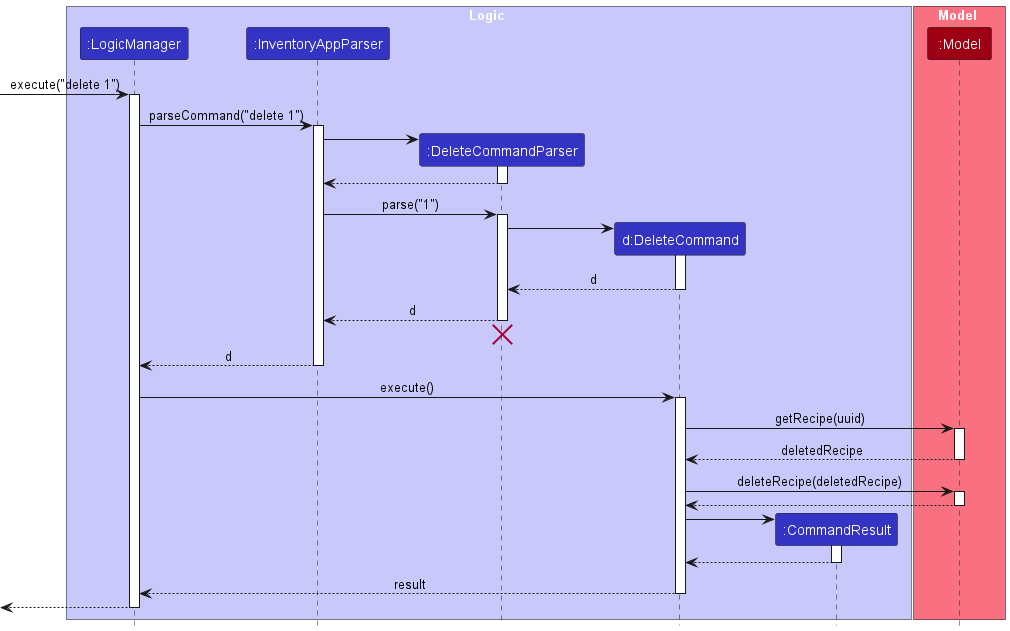
Note: In the diagram, uuid is the UniqueId that was passed into the DeleteCommand object.
Note: The lifeline for DeleteCommandParser should end at the destroy marker (X) but due to a limitation of PlantUML,
the lifeline reaches the end of the diagram.
Modify recipe feature
Implementation
The modify recipe mechanism is implemented as a Command, extending from the Command abstract class.
Given below is an example usage scenario and how the modify recipe mechanism behaves at each step. The application is
assumed to be initialised with at least one recipe loaded in the ModelManager.
Step 1. The user keys in modify i/1 n/Milk q/100 u/g into the UI command box. LogicManager takes this string command
and executes it.
Step 2. InventoryAppParser is then called to parse the modify i/1 n/Milk q/100 u/g command.
Step 3. By Polymorphism, ModifyCommandParser is called on to handle the parsing. The parse(String args) function is
called with the argument of "i/1 n/Milk q/100 u/g" and this is then tokenized into the UUID of the recipe that will be modified,
the modified ingredient's name, amount and unit. An Ingredient is then created with this name, amount and unit specified.
Step 4: A ModifyCommand object is then created with two parameters passed in - the UUID specified
earlier wrapped in a UniqueId constructor as well as the Ingredient created earlier.
Step 5: This ModifyCommand object is then executed. During execution, the recipe that matches with the UniqueId
passed into the ModifyCommand is retrieved from the recipe list through the Model#getRecipe(UniqueId uuid). This is the old recipe
before the ingredients are modified.
Step 6: Following that during the execution, there are 2 possibilities.
If the recipe already contains the ingredient that was specified,
the Recipe#modifyIngredients(String oldIngredient, Ingredient newIngredient) will be called with the
name of the ingredient that is to be modified as well as the Ingredient that was passed into ModifyCommand such that
the amount and unit of the ingredient can be modified.
If the recipe does not already contain the ingredient that was specified, the Recipe#addIngredient(Ingredient ingredient)
will be called with the Ingredient that was passed into ModifyCommand such that the ingredient is added to the
ingredient list of that recipe.
In both cases, this results in the creation of a new recipe object with a modified ingredient list.
Step 7: The Model#deleteRecipe(Recipe recipe) is called with the old recipe that had the ingredient list before
it was modified, deleting the old recipe from the recipe list.
Step 8: The Model#addRecipe(Recipe recipe) is called with the new recipe that has the modified ingredient list, adding the new
recipe to the recipe list.
Step 9: ModifyCommand then calls Model#updateFilteredRecipeList(Predicate<Recipe> predicate), filtering the
recipe list in ModelManager with a RecipeUuidMatchesPredicate, which ultimately shows the recipe that matches
the UniqueId that was passed into ModifyCommand.
Step 10. After execution, the returned CommandResult will then be returned back to the MainWindow to be displayed.
Note: If an invalid UUID (less than or equals to 0) is inputted, a
ParseException will be thrown and users will be informed that the UUID provided is invalid.
Note: If the recipe with that UUID does not exist in the app, a CommandException will be thrown and users will be
informed that there is no recipe with that UUID in the recipe book.
The following sequence diagram shows how the modify recipe feature works:
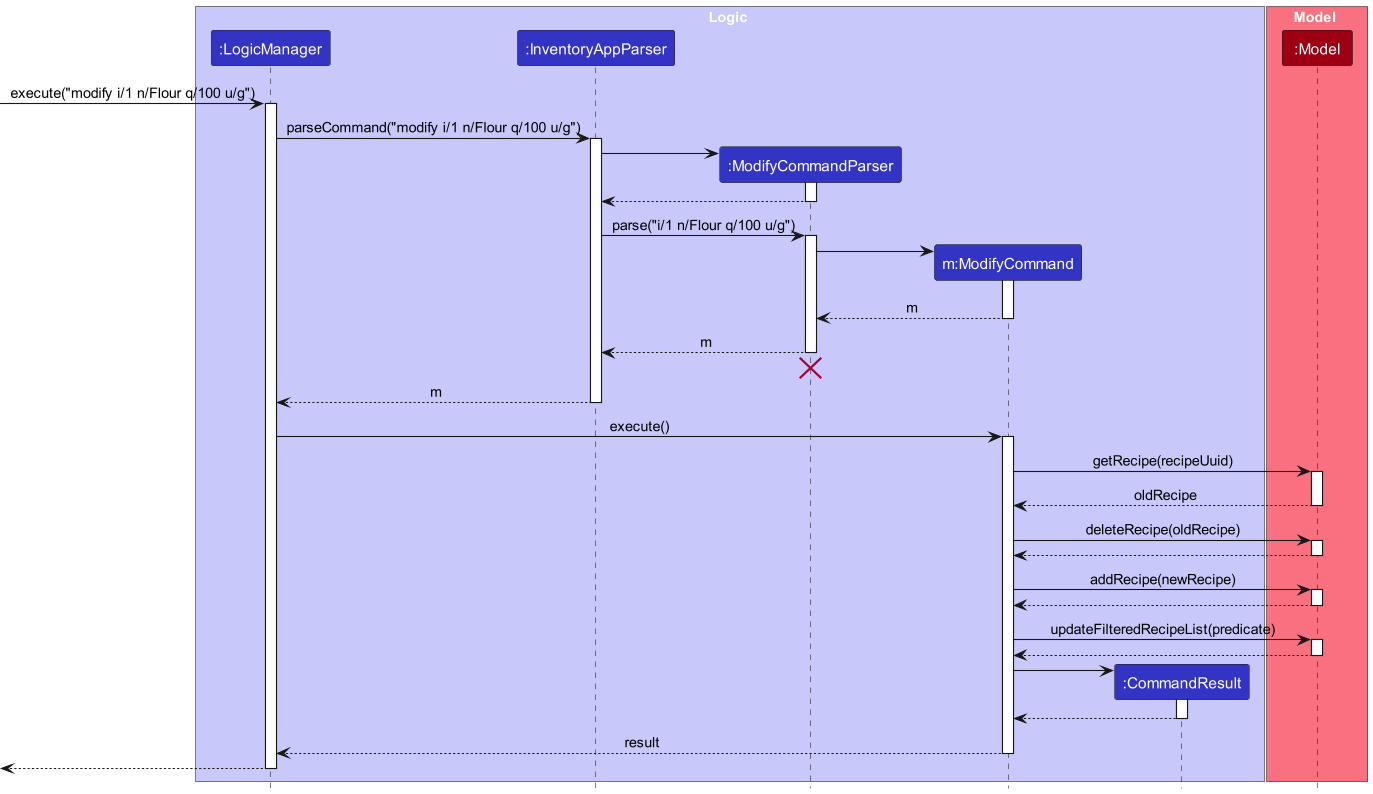
Note: Due to limited space in the sequence diagram, certain behaviour could not be shown.
recipeUuidis theUniqueIdof the recipe that was passed intoModifyCommand.newRecipeis the modified version of the recipe that contains the modified list of ingredients. This recipe was created with interaction withRecipeas mentioned in Step 6 above.predicateis theRecipeUuidMatchesPredicatewith theUniqueIdthat was passed intoModifyCommandas its parameter.
Note: The lifeline for ModifyCommandParser should end at the destroy marker (X) but due to a limitation of PlantUML,
the lifeline reaches the end of the diagram.
Documentation, logging, testing, configuration, dev-ops
Appendix: Requirements
Product Scope
Target User Profile
- is a home-baker
- has a need to manage and use their stock of ingredients
- has a need to manage a significant amount of recipes and view the ingredients needed
- is reasonably comfortable using CLI apps
- prefer desktop apps over other types
- can type fast
Value Propositions
Home-bakers often struggle with managing their recipe book as well as checking if they have the ingredients needed for a particular recipe. This application is designed for home-bakers to easily check what ingredients they already have and search for the recipes that they want along with the necessary ingredients required, which makes baking a more convenient and easy process.
User Stories
Priorities: High (must have) - ***, Medium (nice to have) - **, Low (unlikely to have) - *
| Priority | As a... | I want to ... | So that I can ... |
|---|---|---|---|
*** | baker | view my stock | know what and the quantity of ingredients I have |
*** | baker | add ingredients to my stock | update the stock I have |
*** | baker | reduce ingredients' quantities in my stock | update the stock I have after I used the items |
*** | baker | clear my stock | have an empty stock |
*** | baker | find recipes by name | find a specific recipe |
*** | baker | view recipes | see the steps and ingredients involved |
*** | baker | add recipes to the recipe book | add new recipes in my recipe book |
*** | baker | delete recipes from the recipe book | delete recipes I no longer need |
** | baker | modify recipes' ingredients | make changes to the ingredients needed |
*** | baker | view the ingredients needed for a recipe | know if I have the necessary ingredients |
*** | baker | request for help | learn how to use the recipe book when I'm lost |
Use Cases
(For all use cases below, the System is the RecipeBook and the Actor is the user, unless specified otherwise)
Use case: Add an ingredient to the stock
MSS
User requests to add a specific ingredient to their stock
[Ba]king [Br]ead adds that ingredient to the stock
Use case ends.
Extensions
- 1a. User does not specify the quantity and/or unit of that ingredient
- [Ba]king [Br]ead shows an error message
- 1b. User inputs an invalid quantity (less than or equals to 0 or non-numerical)
- [Ba]king [Br]ead shows an error message
- 1c. The specified unit is not recognised
- [Ba]king [Br]ead shows an error message
- 1d. There is an error in the format of the user's input command.
- [Ba]king [Br]ead shows an error message
- 2a. The ingredient is not in the stock
- [Ba]king [Br]ead will add the ingredient along with its quantity to the stock
- 2b. The ingredient is already in the stock
- [Ba]king [Br]ead will add the quantity specified to the specified ingredient already in the stock
Use case: Reduce items' quantities in the stock
MSS
User requests to use up specific quantities of an ingredient
[Ba]king [Br]ead reduces the quantity of that ingredient in the stock
Use case ends.
Extensions
- 1a. The specified unit is not recognised
- [Ba]king [Br]ead shows an error message
- 1b. User inputs an invalid quantity (less than or equals to 0 or non-numerical)
- [Ba]king [Br]ead shows an error message
- 1c. User either only inputs the quantity or the unit
- [Ba]king [Br]ead shows an error message
- 1d. User inputs a unit that cannot be converted to the unit specified for the specified ingredient in the stock
- [Ba]king [Br]ead shows an error message
- 1e. There is an error in the format of the user's input command.
- [Ba]king [Br]ead shows an error message
- 2a. User does not specify the quantity of that ingredient used
- [Ba]king [Br]ead depletes the entire quantity of that ingredient
- 2b. The quantity the user requests to use is more than the current quantity in stock
- [Ba]king [Br]ead depletes the entire quantity of that ingredient
Use case: View the stock of ingredients
MSS
User requests to view the stock of specific ingredient(s)
[Ba]king [Br]ead shows the ingredient(s) and the quantity of the ingredient(s)
Use case ends.
Extensions
- 1a. The specified ingredient(s) are not in the stock
- [Ba]king [Br]ead shows an error message
- 2a. User does not specify what ingredients they would like to view
- [Ba]king [Br]ead shows the entire stock of ingredients
- 2b. User specified one ingredient they would like to view
- [Ba]king [Br]ead shows the stock of that ingredient
- 2c. User specified more than one ingredient they would like to view
- [Ba]king [Br]ead shows the stock of all the ingredients specified
Use case: Find a specific recipe
MSS
User requests to view a specific recipe
[Ba]king [Br]ead shows the corresponding recipe
Use case ends.
Extensions
- 1a. There is an error in the format of the user's input command
- [Ba]king [Br]ead shows an error message
- 1b. The specified recipe does not exist
- [Ba]king [Br]ead shows an error message
- 1c. The specified recipe UUID inputted is less than 1
- [Ba]king [Br]ead shows an error message
Use case: List all recipes
MSS
User requests to list all possible recipes
[Ba]king [Br]ead lists out all possible recipes
Use case ends.
Extensions
- 2a. There is only one recipe
- The recipe will be displayed in full, inclusive of steps
- 2b. There are multiple recipes
- The recipes will only have their name and required ingredients listed
- 2c. There are currently no recipes stored
- No updates will be made to the screen
Use case: Add a new recipe
MSS
User requests to start adding a recipe
User enters the name of the recipe
User enters the ingredients of the recipe
User enters command to move to the steps portion
User enters the steps of the recipe
User enters command to finalise the add recipe command
[Ba]king [Br]ead adds the recipe to the recipe list
Use case ends
Extensions:
- 2a. Name is not of alphanumeric format
- [Ba]king [Br]ead shows an error message
- 3a. Ingredient inputted does not follow given format
- [Ba]king [Br]ead shows an error message
- 5a. Step inputted does not contain an index at the start
- [Ba]king [Br]ead shows an error message
Use case: Search for a recipe with a specific ingredient
MSS
User requests to search for recipes with a specific ingredient
[Ba]king [Br]ead displays all recipes that uses that specific ingredient
Use case ends
Extensions:
- 1a. User does not input an ingredient
- [Ba]king [Br]ead will show an error message
- 2a. No recipe contains that ingredient
- No recipes will be displayed
- 2b. One recipe contains that ingredient
- That one recipe will be shown in full, inclusive of steps
- 2c. Multiple recipes contain that ingredient
- All recipes will be displayed without the steps
Use case: Delete a recipe from the recipe list
MSS
User requests to delete a specific recipe
[Ba]king [Br]ead deletes the corresponding recipe
Use case ends.
Extensions:
- 1a. The specified recipe does not exist
- [Ba]king [Br]ead shows an error message
- 1b. The specified recipe UUID inputted is less than 1
- [Ba]king [Br]ead shows an error message
- 1c. There is an error in the format of the user's input command.
- [Ba]king [Br]ead shows an error message
Use case: Modify the ingredients in the recipe
- User requests to modify an ingredient in a specific recipe
- [Ba]king [Br]ead modifies the corresponding recipe
Extensions:
- 1a. The specified recipe does not exist
- [Ba]king [Br]ead shows an error message
- 1b. The specified recipe UUID inputted is less than 1
- [Ba]king [Br]ead shows an error message
- 1c. User inputs an invalid quantity (less than or equals to 0 or non-numerical)
- [Ba]king [Br]ead shows an error message
- 1d. The specified unit is not recognised
- [Ba]king [Br]ead shows an error message
- 1e. There is an error in the format of the user's input command.
- [Ba]king [Br]ead shows an error message
- 2a. The ingredient specified in the command is already in the recipe's ingredient list
- [Ba]king [Br]ead modifies the ingredient in the ingredient list of the recipe
- 2b. The ingredient specified in the command is not in the recipe's ingredient list
- [Ba]king [Br]ead adds the ingredient to the ingredient list of the recipe
Non-Functional Requirements
- The system should work on any mainstream OS as long as it has Java
11installed. - The system should be able to hold 500 ingredients and recipes in total without any noticeable sluggishness.
- The system should be usable by any novice who is not familiar with computer programs.
- The system should be understandable by any novice who is not familiar with baking.
- The system should log error messages for user debugging & bug reporting purposes.
- The system should be well-documented for future extension and maintainability.
- The system should be backwards-compatible with data from older versions.
Glossary
- Mainstream OS: Windows, Linux, OS-X
- Unique identifier (UUID): An identifier that is unique to all other identifiers, in this project, each recipe's UUID is unique.
Appendix: Instructions for manual testing
Given below are instructions to test the app manually.
Note: These instructions only provide a starting point for testers to work on; testers are expected to do more exploratory testing.
Launch and shutdown
Initial launch
Download the jar file and copy into an empty folder
Double-click the jar file Expected: Shows the GUI with a set of sample contacts. The window size may not be optimum.
Saving window preferences
Resize the window to an optimum size. Move the window to a different location. Close the window.
Re-launch the app by double-clicking the jar file.
Expected: The most recent window size and location is retained.
Adding an ingredient
- Adding an ingredient with quantity and unit
Test case:
add n/Potato Starch q/100 u/g
Expected: Adds Potato Starch to the ingredients or increases the amount of Potato Starch by 100g if it already exists.Other incorrect add commands to try :
add,add n/Flour
Expected: Error details shown in the command result message.
Using an ingredient
Using an ingredient with quantity and unit or neither
Prerequisites: Ingredients to be used are currently in the ingredient list
Test case:
use n/Flour q/100 u/g
Expected: Uses 100g of Potato Starch or all of it if there is less than 100g of it left.Test case:
use n/Flour
Expected: Uses the entire stock of Potato Starch.Other incorrect add commands to try :
use,use n/Flour q/100
Expected: Error details shown in the command result message.
Viewing of Ingredients
Views all or specific ingredients
Test case:
stock
Expected: Displays all ingredients.Test case:
stock butter
Expected: Displays all ingredients with butter in their name.
Viewing all recipes
Displays all recipes
- Test case:
list
Expected: Displays all recipes.
- Test case:
Viewing a specific recipe
Views a specific recipe based on the UUID
Test case:
view 1
Expected: Displays the recipe with UUID 1.Other incorrect delete commands to try:
view,view x(where x is larger than the list size)
Expected: Error details shown in the command result message.
Adding a recipe
Adds a recipe with the name, ingredients and steps
- Test case:
addrecipe,Bread,Flour 100g,Milk 50g,steps start,1. Mix Flour and Milk,2. Bake at 300C for 30min,complete recipe(Note: Each block represents one line or one input)
Expected: Adds the recipe Bread with the ingredients and steps
- Test case:
Modifying a recipe
Modifies the ingredients of a recipe
Prerequisite: To be modified recipe exists
Test case:
modify i/1 n/Flour q/100 u/g
Expected: Changes the quantity of flour to 100 if the ingredient exists. Adds the ingredient if it does not.
Searching for a recipe with a specific ingredient
Searches for all recipes that contains the ingredient
- Test case:
search flour
Expected: Displays all recipes that uses the ingredient flour
- Test case:
Deleting a recipe
Deleting a recipe while all recipes are being shown
Prerequisites: List all recipes using the
listcommand. Multiple recipes in the list.Test case:
delete 1
Expected: First recipe is deleted from the list. UUID of the deleted recipe shown in the command result message.Test case:
delete 0
Expected: No recipe is deleted. Error details shown in the command result message.Other incorrect delete commands to try:
delete,delete x,...(where x is larger than the list size)
Expected: Similar to previous.
Saving data
Dealing with missing/corrupted data files
- Head over to the folder where your jar file is located and then delete both inventory.json and recipeBook.json within the data folder.
- Restart the application and new sample data should be used instead.
Appendix: Planned Enhancements
1. Recycling of UUIDs after deleting recipes
Currently, the UUIDs for the recipes are unique across deleted and non deleted recipes. As such, when deleting a recipe, the corresponding UUID will no longer be available. For example, if there are recipes with the UUIDs 1, 2 and 3 and recipe with UUID 2 gets deleted, then the next recipe added will have a UUID of 4 instead of 2 as 2 is no longer in use. We plan to make it such that when a recipe gets deleted, the next recipe added will take on this UUID to ensure that the UUID does not end up getting too large.
2. Ensuring at least one ingredient in a recipe
When inputting the ingredients during the addrecipe commands, users are able to entirely skip this portion by just typing steps start. This however is unrealistic as no recipe would require no ingredients to make. We plan to add a sanity check to ensure that at least one ingredient is inserted into the recipe.
3. Ensuring at least one step in a recipe
As a continuation from enhancement 2, addrecipe is also able to execute successfully without inputting any steps. We plan to make it such that users have to input at least one step.
4. Checking only one ingredient inserted
When adding ingredients to a recipe during the addrecipe command, there is no check to ensure that only one ingredient is
being inputted at any point in time. As such, inputs such as flour 100g milk 100g would be parsed as name: flour 100g milk,
quantity: 100 unit: g. We plan to add a check that would ensure only one ingredient can be inputted at one time.
So flour 100g would work but flour 100g milk 100g would return an error message.
5. Allowing for use of default unit
When using ingredients, either both unit and quantity must be inputted or neither must be present. However, it would be
more efficient if we could just use input the quantity and use based on the unit of the ingredient. We plan to add a way
to input only the name and quantity without the units to be more intuitive. For example: use n/flour q/100 will not
show an error but rather, consume 100 of whatever unit that flour is currently stored in.
6. Checking for recipe step
When adding recipe steps during the addrecipe command, the numbering of the steps is entirely dependent on the user and users
can input in the wrong order such as 1 4 5. We plan to add a check where users need not type in the step number and the application will
automatically generate the step index as per the order of steps inputted.
7. Modifying the steps of a recipe
Currently, the modify function only allows users to modify the ingredients in the recipe. However, it may be useful for users to be able to modify the steps of the recipe as well, especially if they want to add on to the ingredients in the list to modify the recipe.
Appendix: Effort
- Significant effort went into refactoring the entire code base to change the AddressBook entities into ingredients and recipes.
- The recipe model and ingredient model were not trivial to design.
- Much consideration was given to the design of the system representing the different units of an ingredient and the conversion between them.
- The recipe model and how to build a recipe is also complex, since a recipe composes of many steps and ingredients.
- Compared to AB3, our application manages more entities and has entities of greater complexity.
- The above also meant the add recipe and modify recipe feature were not easy to implement, and were very bug prone which took effort to fix.
- The UI design took a significant effort, a mockup design was first done on figma to test the color combinations and layouts.
- Figuring out how to change the view from a recipe list to a full recipe view was not simple, how javafx updates its UI components is not explained or easily understood through the UI code.
- The UI is also made to be size responsive, the layout will retain its integrity even if the app is viewed in full-screen.